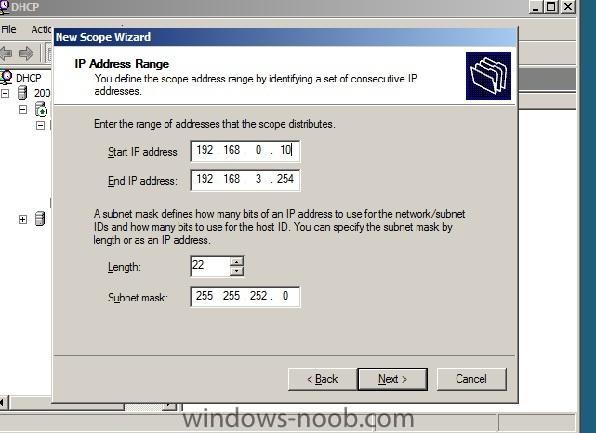
sabe75
Established Members-
Posts
10 -
Joined
-
Last visited
-
Days Won
1
Everything posted by sabe75
-
Watch out for your versions, if you use the newer SDK binaries; you will have the DLL error, I have documented the solution here, including orchestrator natively using PowerShell v3+: http://blogs.catapultsystems.com/mdowst/archive/2013/10/29/install-smlets-on-windows-server-2012-without-scsm-console/
-
Okay, if you want the range of 192.168.0.0 not to see 192.168.1.0 or 2.0 or 3.0 etc... as in four separate scopes/networks then you you need to create 4 scopes with the mask 255.255.255.0 for each (class C) and use a DHCP relay as these are segmented at layer 3, e.g. will need a router to communicate (layer 3). However, if you want these to be one address range with the mask 255.255.252.0 and therefore they all see each other with not router, only switches (layer 2) between the server and the clients then you do not need a DHCP relay agent and require only one scope. I think it would help if you described your network infrastructure a little more, this would probably make your requirement clearer. Kind Regards
-
PS. Could you vote for me, to give me some good reputation.
-
Yes, the ranges 192.168.0-3 are one network because of the mask, they have effectively been added together. You do not need a relay agent as they are not on different networks, unless you have some sort of router between. Please try as is, am sure you will see if will work fine. In my previous network, I actually used that exact subnet. So you are effectively creating a scope from 0.31 --> 3.200 making 254-30=224 on your 0 range, 254 on your 1 and 2 range and 199 on you 3rd. Therefore, 224+254+254+199=931 (remember to exclude the 0 & 255 addresses as these would have been typically used for network ID and broadcast on classfull). Kind Regards
-
Actually, DNS will give you pretty much everything; if your advertising a service it is being advertised from the DNS svr records.... It is more the network infrastructure which is a little more complex, e.g. switches and routers; but start from layer one and follow the cables; you'll find everything pretty soon Kind Regards
-
Please add more information, like what errors the person is seeing in IE; but yes you can configure via GPO.
-
I would use SCCM rather than WDS. It does rely on WDS but you do not configure WDS just SCCM, it allows you to deploy multiple OS images and software as well, you can add in different drivers on a single image; the actual bonus is the extra features like software metering and remote tools. There is also a free alternative to SCCM / WDS; although I have no experience in this. The link is: http://wpkg.org/WPKG_overview Kind Regards
-
-
Create one scope of 192.168.0.0/22, the 22 means subnet mask 255.255.252.0. Therefore a scope of 192.168.0.0 with that particular subnet mask includes: 192.168.0.0-192.168.0.255 192.168.1.0-192.168.1.255 192.168.2.0-192.168.2.255 192.168.3.0-192.168.3.255 The reason being that the 252 in the third octet converts to 11111100, the two 0's represent are the decimal figures of 2 & 1 going left to right and become part of the host section of the address, meaning you can have networks 0,1,2 & 3 (1+2) in the third octet (place of dots) as part of the same network, as normally a classfull 'C' class address would be 255 and therefore binary 11111111 (ones in the mask represents the network part of the address as opposed the host/computer). The technique is called supersubnetting, e.g. adding multiple networks together (as one). Kind Regards
-
Just create a single scope of address range 192.168.0.0/22 mask 255.255.252.0 and create exclusions / reservations for your servers. Kind Regards Sabe75



